Potato pancakes are you tired of bland, soggy potato pancakes that fall apart in the pan and leave you disappointed? I know the struggle all too well. Hi, I’m Jack, and welcome to my kitchen at Cooks Foody!
This recipe for the ultimate potato pancakes will give you golden, crispy on the outside, tender on the inside pancakes that hold together beautifully and deliver incredible flavor in every bite. As someone who’s spent years perfecting comfort food classics, I’ve discovered the secret techniques that transform simple ingredients into restaurant-quality potato pancakes.
In this guide, I’ll walk you through everything you need to know: choosing the right potatoes, mastering the prep techniques that ensure perfect texture, step-by-step cooking instructions, and pro tips that guarantee success every time. Whether you’re making these for a cozy weekend breakfast or serving them as a side dish for dinner, you’ll have all the knowledge you need to create potato pancakes that will have everyone asking for seconds.
Why This Potato Pancakes Recipe Works
These potato pancakes are a game-changer because they focus on three key elements: incredible flavor, foolproof technique, and amazing versatility.
• Uses the perfect potato variety Russet potatoes provide the ideal starch content for crispy exteriors and fluffy interiors
• Simple 15-minute prep with techniques that remove excess moisture for maximum crispiness
• Perfect for any meal serve them for breakfast, lunch, dinner, or as a crowd-pleasing appetizer
• Customizable base that works with dozens of flavor variations to suit any taste preference
• Budget-friendly ingredients that you likely already have in your pantry
Choosing the Right Potatoes for Potato Pancakes
The foundation of exceptional potato pancakes starts with selecting the right type of potato this single choice can make or break your results.
Best Potato Varieties for This Recipe
Russet potatoes are the gold standard for potato pancakes. Their high starch content and low moisture create the perfect texture crispy edges with a fluffy interior. The starch acts as a natural binder, helping your pancakes hold together without becoming gummy.
Yukon Gold potatoes work as a secondary choice, offering a slightly creamier texture with good binding properties, though they won’t get quite as crispy as russets.
Buying Tips for Perfect Potato Pancakes
Look for potatoes that are firm to the touch with smooth, unblemished skin. Avoid any with green spots, soft areas, or sprouting eyes. Medium-sized potatoes (about 6-8 ounces each) are ideal as they’re easier to handle and grate consistently.
Substitutions and Alternatives
If you only have waxy potatoes like red or fingerling varieties, you can still make decent potato pancakes by adding an extra tablespoon of flour to help with binding, though the texture will be denser and less crispy.
Ingredients & Prep for Potato Pancakes

Proper preparation is crucial for achieving the perfect texture in your potato pancakes. Here’s everything you need to know about ingredients and prep work.
Potato Prep Essentials
Grating technique: Use the large holes of a box grater or the shredding disc of a food processor. Grate potatoes just before cooking to prevent oxidation and browning.
Moisture removal: This is the most critical step. After grating, place potatoes in a clean kitchen towel and squeeze out as much liquid as possible. The drier your potatoes, the crispier your pancakes will be.
Onion preparation: Finely grate the onion using the small holes of your grater. This ensures even distribution and prevents large chunks that could make pancakes fall apart.
Binding Agents and Seasonings
Flour and cornstarch combination: Regular flour provides structure while cornstarch adds extra crispiness. For gluten-free options, substitute with almond flour or additional breadcrumbs.
Egg binding: One large egg per batch helps hold everything together. Beat it thoroughly before mixing with the potatoes.
Seasoning balance: Salt not only flavors but also helps draw out remaining moisture. Garlic powder, black pepper, and fresh parsley add layers of flavor without overwhelming the potato taste.
Essential Pantry Staples
Cooking fat: Vegetable oil works best for high-heat frying, though butter can be used for a richer flavor (watch carefully to prevent burning).
Acid for freshness: A squeeze of lemon juice in the potato mixture prevents browning and adds brightness.
If you enjoyed this recipe, be sure to share it with your friends or save it for later!
I’d love to see your unique twist feel free to share your photos on Pinterest
Step-by-Step Cooking Instructions for Potato Pancakes

Follow these detailed steps to create perfect potato pancakes every time.
1. Pre-Cooking Prep for Potato Pancakes
Start by peeling your potatoes (or leave skin on for rustic texture). Grate potatoes using large holes of a box grater. Immediately place grated potatoes in a clean kitchen towel and twist into a bundle. Squeeze firmly over the sink to remove as much liquid as possible you should extract at least ¼ cup of liquid.
Transfer squeezed potatoes to a large bowl. Grate the onion finely and add to potatoes along with the beaten egg, flour, cornstarch, garlic powder, salt, pepper, and parsley. Mix thoroughly until well combined.
2. Cooking Method for Potato Pancakes
Heat ¼ cup oil in a large skillet over medium-high heat. The oil should shimmer but not smoke. Using your hands or a large spoon, form potato mixture into pancakes about 3-4 inches wide and ½ inch thick. Don’t make them too thick or they won’t cook through.
Carefully place pancakes in hot oil, leaving space between each one. Cook for 3-4 minutes on the first side until golden brown and crispy. Flip carefully and cook another 2-3 minutes until the second side is golden.
3. Doneness Check for Potato Pancakes
Perfect potato pancakes should be deep golden brown on both sides with crispy edges. The center should be cooked through but still tender. If they’re browning too quickly, reduce heat slightly. If they’re not crisping up, increase heat and ensure oil is hot enough.
4. Resting and Serving Potato Pancakes
Transfer cooked pancakes to a paper towel-lined plate to drain briefly, then move to a wire rack to maintain crispiness. Serve immediately while hot, or keep warm in a 200°F oven for up to 30 minutes.
Pro Tips for Perfect Potato Pancakes
Master these techniques to ensure your potato pancakes turn out perfectly every time.
Avoiding Soggy or Falling-Apart Pancakes
Don’t skip the moisture removal step this is the #1 reason potato pancakes fail. Squeeze those potatoes until your hands hurt, then squeeze some more.
Don’t overcrowd the pan cook in batches to maintain oil temperature and ensure even browning.
Use the right oil temperature oil should be hot enough that a small piece of potato mixture sizzles immediately when added.
Essential Tool Recommendations for Potato Pancakes
Box grater or food processor with shredding disc for consistent grating
Clean kitchen towels for moisture removal paper towels won’t provide enough pressure
Large, heavy-bottomed skillet for even heat distribution
Thin metal spatula for easy flipping without breaking
Storage & Reheating Tips
Refrigerator storage: Cooked potato pancakes keep for up to 3 days in the refrigerator. Store in a single layer to prevent sticking.
Freezing: Freeze cooked pancakes for up to 3 months. Place parchment paper between layers to prevent sticking.
Reheating: Reheat in a 375°F oven for 5-7 minutes to restore crispiness. Avoid microwaving as it makes them soggy.
Flavor Variations for Potato Pancakes
Transform your basic potato pancakes into exciting new dishes with these delicious variations.
Spicy Twist
Add ½ teaspoon cayenne pepper or 1 tablespoon finely chopped jalapeños to the mixture. For smoky heat, try ½ teaspoon smoked paprika or a pinch of chipotle powder.
Keto/Paleo Friendly
Replace flour with almond flour or coconut flour (use half the amount). These potato pancakes work perfectly for low-carb diets when served with sugar-free toppings.
Global Flavors
Korean-inspired: Add 1 tablespoon gochujang and 1 teaspoon sesame oil to the mixture, garnish with scallions and sesame seeds.
Italian herb: Mix in 1 tablespoon each fresh basil and oregano, plus ¼ cup grated Parmesan cheese.
German-style: Add 2 tablespoons sauerkraut (drained) and 1 teaspoon caraway seeds to the mixture.
Flavor Variations Comparison Table
| Variation | Additional Ingredients | Serving Suggestions | Prep Time |
|---|---|---|---|
| Classic | None | Sour cream, applesauce | 15 minutes |
| Spicy | Cayenne, jalapeños | Cool yogurt sauce | 15 minutes |
| Herb | Fresh herbs, Parmesan | Marinara sauce | 20 minutes |
| Korean | Gochujang, sesame oil | Kimchi, scallions | 15 minutes |
| German | Sauerkraut, caraway | Mustard, pickles | 20 minutes |
Serving Suggestions for Potato Pancakes
Elevate your potato pancakes with these perfect pairing ideas that complement their crispy texture and savory flavor.
Classic toppings: Sour cream and applesauce are traditional favorites that balance the richness with cool, creamy textures and bright acidity.
Savory pairings: Serve alongside scrambled eggs and crispy bacon for a complete breakfast, or pair with roasted vegetables like asparagus or Brussels sprouts for dinner.
Elegant presentations: Top with smoked salmon and crème fraîche for a sophisticated appetizer, or serve with sautéed mushrooms and fresh herbs for a gourmet side dish.
Beverage pairings: Potato pancakes pair beautifully with crisp white wines like Riesling or Sauvignon Blanc, or try them with a light beer like wheat beer or pilsner.
FAQs About Potato Pancakes
Can I use frozen potatoes for potato pancakes?
Fresh potatoes work best, but if using frozen hash browns, thaw completely and squeeze out excess moisture. The texture will be slightly different but still delicious.
How do I fix potato pancakes that won’t hold together?
Add more binding agents try an extra egg or 1-2 tablespoons of flour. Also ensure you’ve removed enough moisture from the potatoes.
Are potato pancakes safe during pregnancy?
Yes, potato pancakes are safe for pregnant women when cooked properly. Ensure they’re cooked through to an internal temperature of 165°F.
Can I make the mixture ahead of time?
It’s best to cook potato pancakes immediately after mixing to prevent the potatoes from browning and becoming watery. If you must prep ahead, add a squeeze of lemon juice to prevent oxidation.
Why are my potato pancakes turning out mushy?
The most common cause is not removing enough moisture from the grated potatoes. Also check that your oil is hot enough if it’s too cool, the pancakes will absorb oil and become soggy.
Conclusion
These ultimate potato pancakes are more than just a recipe they’re a gateway to comfort food perfection that brings families together around the table. With the right techniques for moisture removal, proper seasoning, and careful cooking, you’ll create golden, crispy pancakes that are impossible to resist.
Print
Potato Pancakes Recipe: Ultimate Crispy Golden Perfection in 15 Minutes
- Total Time: 25 minutes
- Yield: 6–8 pancakes 1x
- Diet: Vegetarian
Description
Crispy, golden potato pancakes made with simple ingredients and cooked to perfection ideal for breakfast, brunch, or dinner sides.
Ingredients
2 cups grated Russet or Yukon Gold potatoes
1/2 small onion, grated
1 large egg
2 tbsp all-purpose flour
1/2 tsp garlic powder
Salt and pepper to taste
Oil for frying
Instructions
1. Peel and grate potatoes. Grate onion.
2. Squeeze out all excess moisture using a towel.
3. Mix potatoes, onion, egg, flour, and spices in a bowl.
4. Form into small patties.
5. Heat oil in a skillet over medium heat.
6. Fry patties 3–4 mins per side until golden brown.
7. Drain on paper towels and serve hot.
Notes
You can add shredded cheese or chopped herbs to the mix.
Serve with sour cream or applesauce for a classic touch.
- Prep Time: 10 minutes
- Cook Time: 15 minutes
- Category: Breakfast
- Method: Pan-Fried
- Cuisine: American
Nutrition
- Serving Size: 2 pancakes
- Calories: 150
- Sugar: 1g
- Sodium: 180mg
- Fat: 7g
- Saturated Fat: 1g
- Unsaturated Fat: 6g
- Trans Fat: 0g
- Carbohydrates: 18g
- Fiber: 2g
- Protein: 3g
- Cholesterol: 40mg
Keywords: potato pancakes, crispy breakfast, easy brunch

